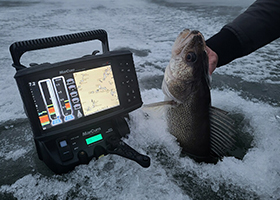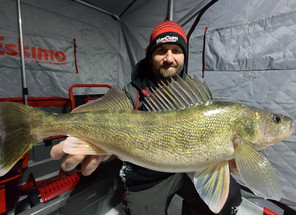Posted by Chris Larsen on 21st Jul 2023
Seven Ice Fishing Tips For Jigging Walleyes With Spoons
Jigging spoons are probably the most effective and versatile lure you can use to catch walleyes through the ice. Buck-Shot Spoons, Tingler Spoons, Swedish Pimples, Quiver Spoons, Glow Spoons, and Kastmasters… just to name a handful.
Here are seven tips for catching more walleyes through the ice with jigging spoons.
Choose the right spoon: Select spoons that mimic the baitfish that walleyes commonly feed on, such as shiners, perch, or smelt. Perch or fire tiger patterns are awesome. But blue, black, and purple are also great when conditions are right. In clear water, I’ll go with a silver or gold. Gold always works! Spoons that have a natural color pattern and realistic wobbling action are more likely to attract walleyes.
Find the right spot: Before heading out, gather information about the water body you intend to fish. Look for underwater structures like drop-offs, rocky areas, or submerged points, as walleyes often hold around these locations. If I’m fishing mid-day, I’m typically looking for flats and small pieces of structure out in deeper water. In the evenings and mornings, transition areas and shallows have been best for me.

Jigging Technique: When using spoons for walleyes, an effective jigging technique is crucial. Start by dropping the spoon down the hole and letting it sink to the desired depth. Then, use a combination of short and long jigging motions to imitate the erratic movements of injured baitfish. Some anglers find success with a "lift and pause" method, where they lift the spoon a few inches and then let it flutter back down. Walleyes often strike during the pause, so be ready for a sudden hit. If I’m not marking fish, I’ll try a few different things. First, I’ll pound the bottom. The goal is to make some noise and kick up some dust. If that doesn’t work, I’ll work higher spots in the water column, this is especially effective on clear water lakes like Mille Lacs.
If you’re marking fish but they’re not biting, add a second deadstick line. You’ll often bring fish in on the spoon and catch them on the deadstick. The Catch Cover Rod Holder is the perfect accessory for deadsticking. Check it out by clicking here. Another mistake I often see is ice anglers, “dropping it in their face”. This is completely unnatural. Bait doesn’t chase predators. Play cat and mouse with the fish. If you can get them to swim vertically to your lure, there’s a good chance you can get them to strike.
Add Live Bait: While spoons can be effective on their own, adding a small piece of live bait, such as a minnow or a minnow head, can make them even more enticing to walleyes. The scent and movement of the live bait can be the extra incentive that triggers a strike. The meat will make them eat!
Stay Mobile: If you're not getting any bites in a particular spot, don't be afraid to move around. Ice fishing for walleyes often involves searching for active fish, so drilling multiple holes and exploring different areas can increase your chances of success.
Use The Right Rod: Noodle rods and super light rods are all the rage right now. But they’re not designed for fishing with spoons. Spoons are heavy. For jigging spoons for walleyes, I like a 32” medium heavy rod with a fast action. I want to be able to pin that hook in them quickly, especially if I’m jigging in 20 feet of water or more. 32” is perfect for in the fish house. If you’re going to be out and about, a longer rod will be beneficial. Look for something 36” or more. I use the Elliott Nomad when out on the open ice and an Elliott Rippineyes for fishing in the fish house.
Camera: This is super effective in the weeds. It’s tough to mark walleyes in the vegetation using a sonar. Drop a camera down and you’ll see fish you can’t find with a sonar. I love the MarCum Quest HD and the Pursuit HD.
Fishing with jigging spoons is one of the most effective ways to catch walleyes through the ice. Use these tips for more success on the ice this winter.
To listen to an audio version of this article, click the player below.

